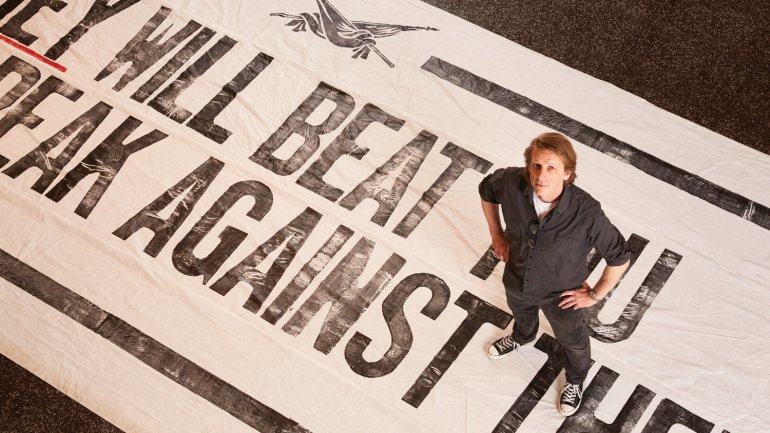Louder Than Words
Louder Than Words
They sprang up in the spring of 1989 in Communist-ruled Poland: thousands of posters of Gary Cooper in the 1952 Western High Noon, a call for citizens to vote in the country’s upcoming parliamentary elections. Emblazoned in red was the logo of Solidarity, the insurgent labor union that had burgeoned into the front of a popular revolt against the entrenched authoritarian regime. The image of the classic American cowboy, headed for a showdown with the bad guys, resonated as a symbol of courage and triumph against the odds.
The Solidarity party won in a landslide, shocking the world and sparking a wave of nonviolent revolution that led to the fall of communism in Europe and beyond.
Piotr Szyhalski remembers that poster well. Born in Poland in 1967, he grew up amid a widespread understanding of the reality of systemic oppression. “It was palpable to everybody,” says the artist, now living in Minneapolis. The experience of the Solidarity movement and its aftermath is one he knows he’ll never live through again.“There was a sense of elation, and a certain purity in that experience, because of its shared collective reach,” he recalls. “It changed how you were breathing.” And art – extensively replicated and distributed on posters and leaflets – played a crucial role.
“It was a big part of my aesthetic and social consciousness to understand without any doubt that a piece of printed artwork has a direct function in that social and cultural sphere, that [it] connects, communicates, unifies, creates emotional bonds, generates energy,” he says. “That’s huge, you know? Think of a young, budding artist absorbing that as the norm.”
And so, from his earliest experiments with mail art in Poland, Szyhalski – who moved to the US in 1990 to exhibit and teach – has centered his practice on crafting situations that harness art’s power to provoke discourse around the complex social and political issues of the day, from war to economic disparity to the omnipotence of social media. His output defies labels, moving in all kinds of formal and conceptual directions – print, photography, installation, film, internet, music, performance, and, often, collaboration with the public. The connecting thread is his view that art is a shared experience between artist, artwork, and audience. Always he embeds what he calls “porousness” – openings for people to wander in, engage on their own terms, and take ownership.
Now Szyhalski is intent on exploring the expressive potential of print on a grand scale. He’s in the process of setting up a kind of public-access letterpress printer, an eccentric device where people can use their body weight to make inked impressions, one letter at a time. And they’re huge letters: Each is more than 2 feet high, cut by Szyhalski out of insulation foam, in the same font as those hardware-store letter stickers that go on mailboxes. The print surface is a continuous roll of white synthetic hospital-gown material, about 3 feet wide. (Szyhalski, who loves using “proletarian materials,” found a stockpile of discarded spools of the stuff.)
With this “insanely dysfunctional” contraption – his description – people get to visualize and amplify their voices on scrolls of any length. Banners produced on the apparatus have been carried for various causes through the Twin Cities streets and at the Standing Rock Indian reservation in North Dakota, the Women’s March on Washington, DC, and the Museum of Modern Art in New York. POWER TO THE PEOPLE, they shout in big, loud, emphatic, all-caps voices. ONLY LOVE AND TRUTH. RESIST.
It all started one morning in late 2015, as Szyhalski drank coffee and browsed Facebook. He spotted a post about a demonstration planned in Minneapolis to protest the police shooting death of Jamar Clark, a young African American man. Szyhalski had just opened a show at a local art space featuring the large-scale printer. Realizing he had something unique to offer, he invited marchers to post messages for him to print and to come help him if they wished. By the time he got to the gallery, people had already shown up. They kept coming, and the printing went on all day, producing banners that proclaimed JUSTICE FOR JAMAR! and more.
It was a profound moment for him, he says, a way to be present and active in the spirit of the event while “not taking the spotlight away from where it needed to be.” Out in the world, the banners became the embodiment of an effective alliance. “People talk about how insular art exhibitions can be. You put something in a gallery, a museum, and it lives in a protected space,” Szyhalski observes. “With these banners, that edge, that boundary between those two spaces, disappeared organically, in a simple way.” It was then that he decided to look for a production space so that the printer could one day be permanently accessible to the public, for free.
In an age of protest, big, bold, collective expression seems as timely and relevant as art can get. And yet, as a professor at the Minneapolis College of Art and Design, Szyhalski finds his students skeptical of their ability to make an impact. “When we talk about current political situations, they say, ‘Does this really matter? How can art possibly have any effect on any of us?’ Clearly, we’re all rendered powerless in so many ways.” Somehow, he says, he manages to retain the idealism necessary to continue his work – a belief that art can shake the earth, or at least shape a destiny.
“Do you remember,” he asks, “the moment you experienced some form of artwork that was so profoundly inspiring that it somehow changed your life, made you think, ‘Maybe that’s what I want to do’? I had those experiences as a kid, and it changed my life. It’s not metaphor, not hyperbole. It’s what happened. I do what I do today because of that. That’s enough evidence for me.”

